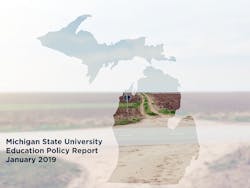Study says Michigan ranks dead last among states in total education revenue growth
Funding for Michigan’s public schools has fallen more sharply than any other state over the past quarter century, a Michigan State University study has concluded.
The study, “Michigan School Finance at the Crossroads: A Quarter Century of State Control,” found that total revenue for Michigan schools has declined by 30 percent since 2002 when adjusted for inflation, the study shows. Education revenue in Michigan in 2015 was only 82 percent of the state's 1995 revenue.
"No other state is close to a decline of this magnitude," the study asserts.
David Arsen, MSU professor of education policy and lead author of the study, says: “Michigan has tried to improve schools on the cheap, focusing on more accountability and school choice. To make those policies effective, they have to be matched with adequate funding. We have been kidding ourselves to think we can move forward while cutting funding for schools."
The study was co-authored by MSU doctoral students Tanner Delpier and Jesse Nagel, the university says in a news release.
Today, Michigan covers less than one-third of costs for federally required special education, which means school districts devote, on average, $500 per student of general education dollars each year to pay for those services. In addition, students from low-income families now account for half of all students, but per-pupil state support for them has dropped even more sharply, by 60 percent.
Although they don’t prescribe specific sources, Arsen and the co-authors say lawmakers must find new revenue to support education. This can occur through changes in sales, property or income tax policy, stricter scrutiny of tax expenditures and by allowing local districts to levy voter-approved enhancement millages.
“Citizens will support providing additional funding to schools if they know how the money will be spent, and they believe the revenues have been raised fairly,” Arsen says. “Providing those resources to schools is well within reach of the state in our current economy. This is what’s necessary to establish the foundation for the important work of teaching and learning.”
About the Author
Mike Kennedy
Senior Editor
Mike Kennedy, senior editor, has written for AS&U on a wide range of educational issues since 1999.
